
2009-2010 Influenza Season Week 51 ending December 26, 2009
All data are preliminary and may change as more reports are received.
Synopsis:
During week 51 (December 20-26, 2009), influenza activity decreased slightly in the U.S.
- 154 (3.9%) specimens tested by U.S. World Health Organization (WHO) and National Respiratory and Enteric Virus Surveillance System (NREVSS) collaborating laboratories and reported to CDC/Influenza Division were positive for influenza.
- All subtyped influenza A viruses reported to CDC were 2009 influenza A (H1N1) viruses.
- The proportion of deaths attributed to pneumonia and influenza (P&I) was above the epidemic threshold.
- Four influenza-associated pediatric deaths were reported. Two of these deaths were associated with 2009 influenza A (H1N1) virus infection and two were associated with an influenza A virus for which the subtype was undetermined.
- The proportion of outpatient visits for influenza-like illness (ILI) was 3.2% which is above the national baseline of 2.3%. Two of the 10 regions (1 and 10) reported ILI below region-specific baseline levels.
- o Four states reported geographically widespread influenza activity, 13 states reported regional influenza activity, the District of Columbia, Puerto Rico, and 19 states reported local influenza activity, Guam and 13 states reported sporadic influenza activity, and one state reported no influenza activity, the U.S. Virgin Islands did not report.
HHS Surveillance Regions* |
Data for current week | Data cumulative since August 30, 2009 (Week 35)* | ||||||||
|---|---|---|---|---|---|---|---|---|---|---|
| Out-patient ILI? | % positive for flu? | Number of jurisdictions reporting regional or widespread activity§ | A (H1) | A (H3) | 2009 A (H1N1) | A (unable to sub-type)¥ | A(Subtyping not performed) | B | Pediatric Deaths | |
| Nation | Elevated | 3.9 % | 17 of 54 | 29 | 52 | 60,403 | 311 | 18,982 | 218 | 225 |
| Region 1 | Normal | 6.7 % | 2 of 6 | 6 | 4 | 3,304 | 14 | 467 | 12 | 6 |
| Region 2 | Elevated | 8.2 % | 2 of 4 | 2 | 4 | 1,340 | 0 | 1,065 | 6 | 9 |
| Region 3 | Elevated | 4.8 % | 2 of 6 | 3 | 7 | 10,514 | 48 | 1,450 | 15 | 13 |
| Region 4 | Elevated | 7.9 % | 5 of 8 | 0 | 4 | 7,035 | 88 | 4,089 | 57 | 44 |
| Region 5 | Elevated | 6.8 % | 1 of 6 | 7 | 22 | 9,276 | 52 | 1,324 | 15 | 29 |
| Region 6 | Elevated | 2.9 % | 1 of 5 | 0 | 3 | 3,312 | 45 | 4,669 | 39 | 64 |
| Region 7 | Elevated | 3.1 % | 0 of 4 | 3 | 1 | 3,277 | 3 | 762 | 3 | 8 |
| Region 8 | Elevated | 5.3 % | 0 of 6 | 6 | 2 | 9,709 | 0 | 3,684 | 60 | 13 |
| Region 9 | Elevated | 10.0 % | 4 of 5 | 0 | 4 | 8,136 | 47 | 1,149 | 9 | 30 |
| Region 10 | Normal | 8.5 % | 0 of 4 | 2 | 1 | 4,500 | 14 | 323 | 2 | 9 |
*Influenza season officially begins each year at week 40. This season data from week 35 will be included to show the trend of influenza activity before the official start of the 2009-10 influenza season.
**HHS regions (Region 1 CT, ME, MA, NH, RI, VT; Region 2: NJ, NY, Puerto Rico, US Virgin Islands; Region 3: DE, DC, MD, PA, VA, WV; Region 4: AL, FL, GA, KY, MS, NC, SC, TN; Region 5: IL, IN, MI, MN, OH, WI; Region 6: AR, LA, NM, OK, TX; Region 7: IA, KS, MO, NE; Region 8: CO, MT, ND, SD, UT, WY; Region 9: AZ, CA, Guam, HI, NV; and Region 10: AK, ID, OR, WA).
† Elevated means the % of visits for ILI is at or above the national or region-specific baseline
‡ National data are for current week; regional data are for the most recent three weeks
§ Includes all 50 states, the District of Columbia, Guam, Puerto Rico, and U.S. Virgin Islands
¥ Subtyping results for the majority of specimens in this category were inconclusive because of low virus titers.
U.S. Virologic Surveillance:
WHO and NREVSS collaborating laboratories located in all 50 states and Washington D.C., report to CDC the number of respiratory specimens tested for influenza and the number positive by influenza type and subtype. The results of tests performed during the current week are summarized in the table below.
| Week 51 | |
|---|---|
| No. of specimens tested | 3,906 |
| No. of positive specimens (%) | 154 (3.9%) |
| Positive specimens by type/subtype | |
| Influenza A | 154 (100.0%) |
| A (2009 H1N1) | 78 (50.6%) |
| A (subtyping not performed) | 76 (49.4%) |
| A (unable to subtype) | 0 (0.0%) |
| A (H3) | 0 (0.0%) |
| A (H1) | 0 (0.0%) |
| Influenza B | 0 (0.0%) |
During week 51, all influenza viruses reported to CDC this week were influenza A, and all subtyped influenza A viruses were 2009 influenza A (H1N1).
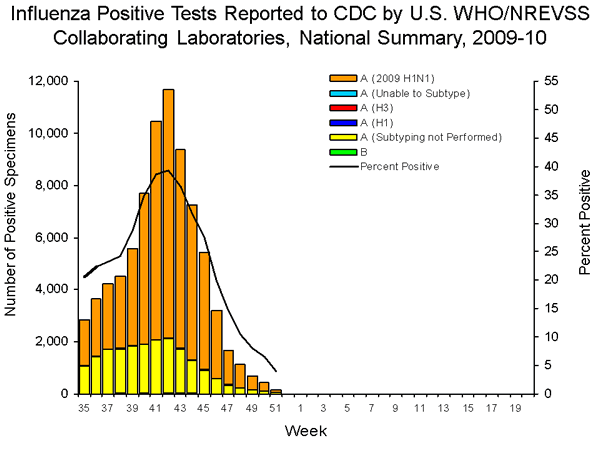
View WHO-NREVSS Regional Bar Charts | View Chart Data | View Full Screen | View PowerPoint Presentation
Pneumonia and Influenza Hospitalization and Death Tracking:
This new system was implemented on August 30, 2009, and replaces the weekly report of laboratory confirmed 2009 H1N1-related hospitalizations and deaths that began in April 2009. Jurisdictions can now report to CDC counts of hospitalizations and deaths resulting from all types or subtypes of influenza, not just those from 2009 H1N1 influenza virus. To allow jurisdictions to implement the new case definition, counts were reset to zero on August 30, 2009. From August 30 – December 26, 2009, 37,090 laboratory-confirmed influenza-associated hospitalizations and 1,697 laboratory-confirmed influenza-associated deaths were reported to CDC. CDC will continue to use its traditional surveillance systems to track the progress of the 2009-10 influenza season.
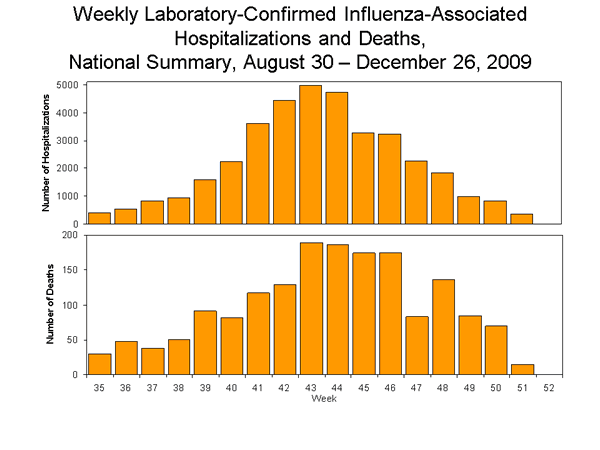
View Full Screen | View Chart Data | View PowerPoint Presentation
Antigenic Characterization:
CDC has antigenically characterized one seasonal influenza A (H1N1), six influenza A (H3N2), five influenza B, and 658 2009 influenza A (H1N1) viruses collected since September 1, 2009.
One seasonal influenza A (H1N1) virus was tested and is related to the influenza A (H1N1) component of the 2009-10 Northern Hemisphere influenza vaccine (A/Brisbane/59/2007).
The six influenza A (H3N2) viruses tested showed reduced titers with antisera produced against A/Brisbane/10/2007, the 2009-2010 Northern Hemisphere influenza A (H3N2) vaccine component, and were antigenically related to A/Perth/16/2009, the WHO recommended influenza A (H3N2) component of the 2010 Southern Hemisphere vaccine formulation.
Influenza B viruses currently circulating globally can be divided into two distinct lineages represented by the B/Yamagata/16/88 and B/Victoria/02/87 viruses. The influenza B component of the 2009-10 vaccine belongs to the B/Victoria lineage. The five influenza B viruses tested belong to the B/Victoria lineage and are related to the influenza vaccine component for the 2009-10 Northern Hemisphere influenza vaccine (B/Brisbane/60/2008).
Six hundred fifty-six (99.7%) of 658 2009 influenza A (H1N1) viruses tested are related to the A/California/07/2009 (H1N1) reference virus selected by WHO as the 2009 H1N1 vaccine virus. Two viruses (0.3%) tested showed reduced titers with antiserum produced against A/California/07/2009.
Annual influenza vaccination is expected to provide the best protection against those virus strains that are related to the vaccine strains, but limited to no protection may be expected when the vaccine and circulating virus strains are so different as to be from different lineages. Antigenic characterization of 2009 influenza A (H1N1) viruses indicates that these viruses are only distantly related antigenically and genetically to seasonal influenza A (H1N1) viruses, suggesting that little to no protection would be expected from vaccination with seasonal influenza vaccine. It is too early in the influenza season to determine if seasonal influenza viruses will circulate widely or how well the seasonal vaccine and circulating strains will match.
Antiviral Resistance:
Since September 1, 2009, one seasonal influenza A (H1N1), eight influenza A (H3N2), one influenza B, and 666 2009 influenza A (H1N1) virus isolates have been tested for resistance to the neuraminidase inhibitors (oseltamivir and zanamivir), and 1,779 2009 influenza A (H1N1) original clinical samples were tested for a single known mutation in the virus that confers oseltamivir resistance. In addition, two seasonal influenza A (H1N1), six influenza A (H3N2), and 685 2009 influenza A (H1N1) virus isolates have been tested for resistance to the adamantanes (amantadine and rimantadine). The results of antiviral resistance testing performed on these viruses are summarized in the table below. Additional laboratories perform antiviral testing and report their results to CDC and positive results from that testing are included in the footnote.
| Samples tested (n) | Resistant Viruses, Number (%) |
Samples tested (n) | Resistant Viruses, Number (%) | Samples tested (n) | Resistant Viruses, Number (%) | |
|---|---|---|---|---|---|---|
| Oseltamivir | Zanamivir | Adamantanes | ||||
| Seasonal Influenza A (H1N1) | 1 | 1 (100.0) | 0 | 0 (0) | 2 | 0 (0) |
| Influenza A (H3N2) | 8 | 0 (0) | 0 | 0 (0) | 6 | 5 (83.3) |
| Influenza B | 1 | 0 (0) | 0 | 0 (0) | N/A* | N/A* |
| 2009 Influenza A (H1N1) | 2445 | 38?? (1.6) | 666 | 0 (0) | 685 | 684 (99.9) |
*The adamantanes (amantadine and rimantadine) are not effective against influenza B viruses.
†Two screening tools were used to determine oseltamivir resistance: sequence analysis of viral genes or a neuraminidase inhibition assay.
‡Additional laboratories perform antiviral resistance testing and report their results to CDC. Two additional oseltamivir resistant 2009 influenza A (H1N1) virus has been identified by these laboratories since September 1, 2009, bringing the total number to 40.
All of the subtyped influenza A viruses reported during week 51 were 2009 influenza A (H1N1) viruses, and nearly all of 2009 H1N1 viruses tested since April 2009 have been resistant to the adamantanes (amantadine and rimantadine).
Antiviral treatment with oseltamivir or zanamivir is recommended for all patients with confirmed or suspected influenza virus infection who are hospitalized or who are at higher risk for influenza complications. Additional information on antiviral recommendations for treatment and chemoprophylaxis of influenza virus infection is available at http://www.cy118119.com/h1n1flu/recommendations.htm.
2009 influenza A (H1N1) viruses were tested for oseltamivir resistance by a neuraminidase inhibition assay and/or detection of genetic sequence mutation, depending on the type of specimen tested. Original clinical samples were examined for a single known mutation in the virus that confers oseltamivir resistance in currently circulating seasonal influenza A (H1N1) viruses, while influenza virus isolates were tested using a neuraminidase inhibition assay that determines the presence or absence of neuraminidase inhibitor resistance, followed by neuraminidase gene sequence analysis of resistant viruses.
The majority of 2009 influenza A (H1N1) viruses are susceptible to the neuraminidase inhibitor antiviral medication oseltamivir; however, rare sporadic cases of oseltamivir resistant 2009 influenza A (H1N1) viruses have been detected worldwide. A total of 50 cases of oseltamivir resistant 2009 influenza A (H1N1) viruses have been identified in the United States since April 2009, including four newly identified cases since last week. In specimens collected since September 1, 2009, 40 cases have been identified in the United States. The proportion of oseltamivir-resistant 2009 H1N1 viruses does not represent the prevalence of oseltamivir-resistant 2009 H1N1 in the U.S. Most cases were tested because drug resistance was suspected. All tested viruses retain their sensitivity to the neuraminidase inhibitor zanamivir. Of the 50 total cases identified since April 2009, 34 patients had documented exposure to oseltamivir through either treatment or chemoprophylaxis, 14 patients are under investigation to determine exposure to oseltamivir, and two patients had no documented oseltamivir exposure. Occasional development of oseltamivir resistance during treatment or prophylaxis is not unexpected. Enhanced surveillance, an increased availability of testing performed at CDC, and an increasing number of public health and other clinical laboratories performing antiviral resistance testing increase the number of cases of oseltamivir resistant 2009 influenza A (H1N1) viruses detected. All cases are investigated to assess the spread of resistant strains in the community.
To prevent the spread of antiviral resistant virus strains, CDC reminds clinicians and the public of the need to continue hand and cough hygiene measures for the duration of any symptoms of influenza, even while taking antiviral medications (http://www.cy118119.com/mmwr/preview/mmwrhtml/mm5832a3.htm).
Pneumonia and Influenza (P&I) Mortality Surveillance
During week 51, 7.7% of all deaths reported through the 122-Cities Mortality Reporting System were due to P&I. This percentage was above the epidemic threshold of 7.4% for week 51.
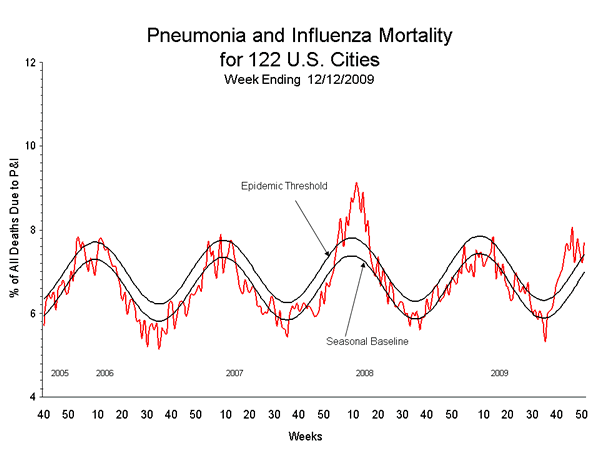
View Full Screen | View PowerPoint Presentation
Influenza-Associated Pediatric Mortality
Four influenza-associated pediatric deaths were reported to CDC during week 51 (Florida [2], Massachusetts, and Texas). Two of these deaths were associated with 2009 influenza A (H1N1) virus infection and two were associated with an influenza A virus for which the subtype is undetermined. The deaths reported during week 51 occurred between August 30 and December 19, 2009.
Since August 30, 2009, CDC has received 225 reports of influenza-associated pediatric deaths that occurred during the current influenza season (42 deaths in children less than 2 years old, 25 deaths in children 2-4 years old, 83 deaths in children 5-11 years old, and 75 deaths in children 12-17 years old). One hundred eighty-three (81%) of the 225 deaths were due to 2009 influenza A (H1N1) virus infections, 41 were associated with influenza A virus for which the subtype is undetermined, and one was associated with an influenza B virus infection. A total of 243 deaths in children associated with 2009 influenza A (H1N1) virus infection have been reported to CDC.
Among the 225 deaths in children, 106 children had specimens collected for bacterial culture from normally sterile sites and 35 (33.0%) of the 106 were positive; Streptococcus pneumoniae was identified in 10 (28.6%) of the 35 children and Staphylococcus aureus was identified in 10 (28.6%) of the 35 children. Two S. aureus isolates were sensitive to methicillin, seven were methicillin resistant, and one did not have sensitivity testing performed. Twenty-three (65.7%) of the 35 children with bacterial coinfections were five years of age or older, and 11 (31.4%) of the 35 children were 12 years of age or older.
| Date | 2009 H1N1 Influenza | Influenza A-Subtype Unknown | Seasonal Influenza | Total |
|---|---|---|---|---|
| Number of Deaths REPORTED for Current Week – Week 51 (Week ending December 26, 2009) | 2 | 2 | 0 | 4 |
| Number of Deaths OCCURRED since August 30, 2009 | 183 | 41 | 1 | 225 |
| Number of Deaths OCCURRED since April 26, 2009 | 243 | 44 | 2 | 289 |
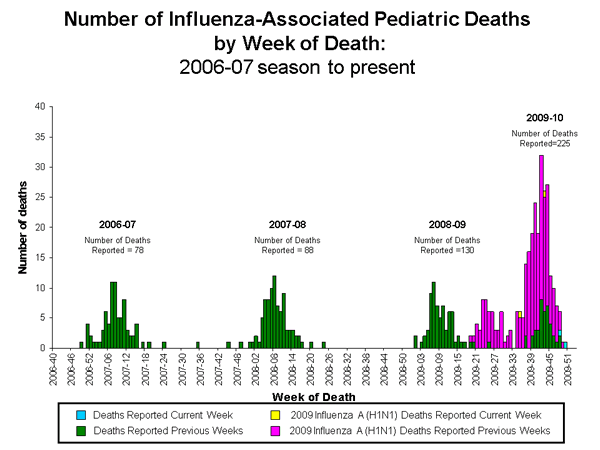
View Full Screen | View PowerPoint Presentation
Influenza-Associated Hospitalizations
Laboratory-confirmed influenza-associated hospitalizations are monitored using a population-based surveillance network that includes the 10 Emerging Infections Program (EIP) sites (CA, CO, CT, GA, MD, MN, NM, NY, OR and TN) and six new sites (IA, ID, MI, ND, OK and SD).
During September 1, 2009 – December 26, 2009, the following preliminary laboratory-confirmed overall influenza associated hospitalization rates were reported by EIP and the new sites (rates include influenza A, influenza B, and 2009 influenza A (H1N1)):
Rates [EIP (new sites)] for children aged 0-4 years and 5-17 years were 5.5 (9.4) and 2.4 (3.6) per 10,000, respectively. Rates [EIP (new sites)] for adults aged 18-49 years, 50-64 years, and ≥ 65 years were 2.2 (1.7), 2.8 (1.8) and 2.3 (1.6) per 10,000, respectively.
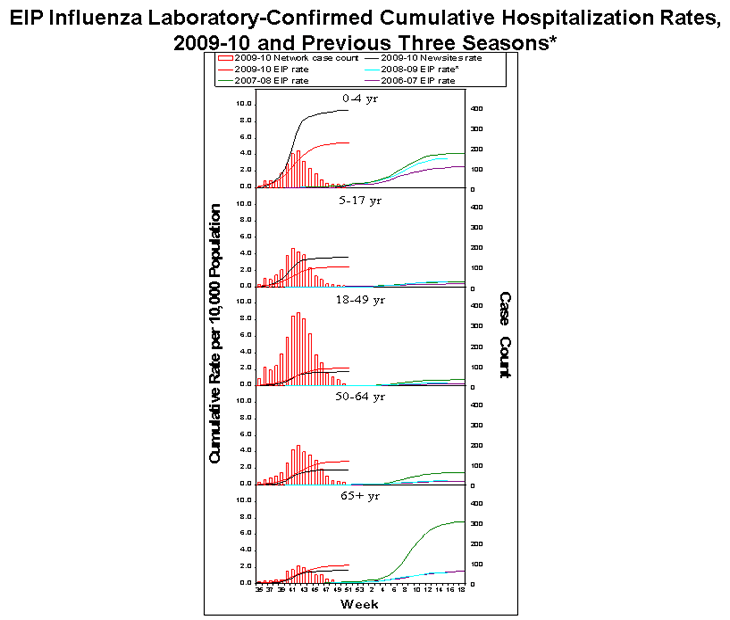
*The 2008-09 EIP rate ended as of April 14, 2009 due to the onset of the 2009 H1N1 season.
View Full Screen | View PowerPoint Presentation
Outpatient Illness Surveillance:
Nationwide during week 51, 3.2% of patient visits reported through the U.S. Outpatient Influenza-like Illness Surveillance Network (ILINet) were due to influenza-like illness (ILI). This percentage is above the national baseline of 2.3%.
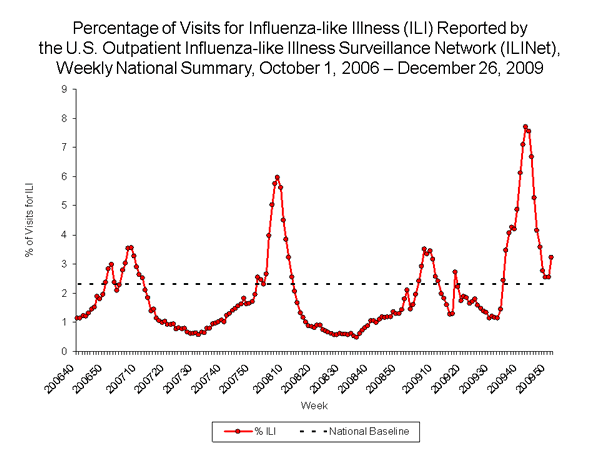
View ILINet Regional Charts | View Chart Data | View Full Screen | View PowerPoint Presentation
On a regional level, the percentage of outpatient visits for ILI ranged from 1.1% to 4.7% during week 51. Eight of the 10 regions reported a proportion of outpatient visits for ILI at or above their region-specific baseline levels. Regions 1 and 10 reported ILI below their region-specific baselines.
Geographic Spread of Influenza as Assessed by State and Territorial Epidemiologists:
The influenza activity reported by state and territorial epidemiologists indicates geographic spread of both seasonal influenza and 2009 influenza A (H1N1) viruses and does not measure the severity of influenza activity.
- During week 51, the following influenza activity was reported:
- Widespread influenza activity was reported by four states (Delaware, Maine, New Jersey, and Virginia).
- Regional influenza activity was reported by 13 states (Alabama, Arizona, California, Connecticut, Florida, Georgia, Hawaii, Indiana, Kentucky, Nevada, New Mexico, New York, and Tennessee).
- Local influenza activity was reported by the District of Columbia, Puerto Rico, and 19 states (Alaska, Colorado, Illinois, Louisiana, Maryland, Massachusetts, Michigan, Mississippi, Montana, North Carolina, Oklahoma, Oregon, Pennsylvania, Rhode Island, South Carolina, Texas, Utah, Vermont, and Washington).
- Sporadic influenza activity was reported by Guam, and 13 states (Arkansas, Idaho, Iowa, Kansas, Minnesota, Missouri, New Hampshire, North Dakota, Ohio, South Dakota, West Virginia, Wisconsin, and Wyoming).
- One state (Nebraska) reported no influenza activity.
- The U.S. Virgin Islands did not report.
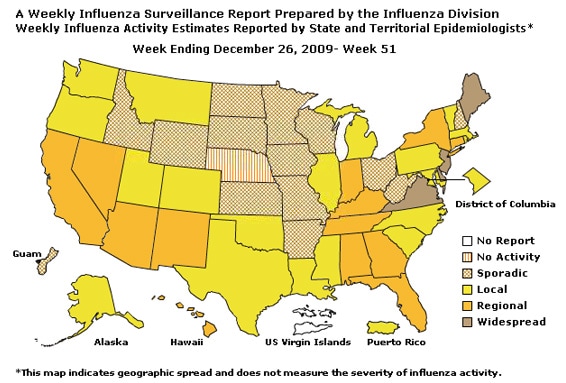
--------------------------------------------------------------------------------
A description of surveillance methods is available at: http://www.cy118119.com/flu/weekly/fluactivity.htm


